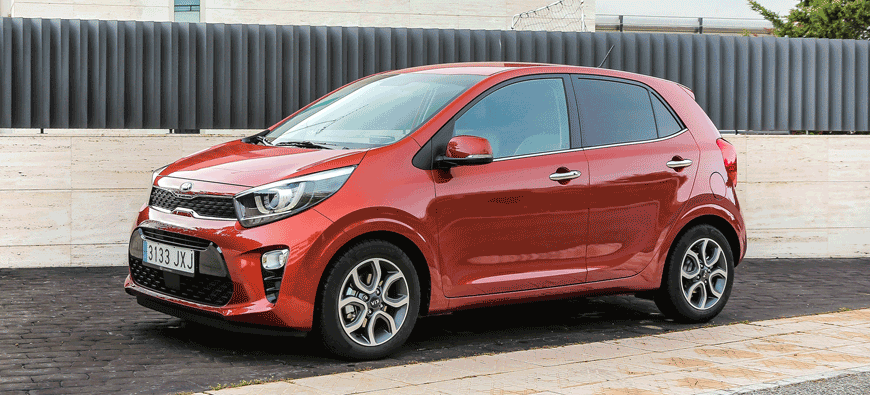You are here
Kia Picanto 1.2L: Perky persona
By Ghaith Madadha - Dec 19,2022 - Last updated at Dec 19,2022

Photo courtesy of Kia
A popular fleet and entry-level seller in previous iterations, the Kia Picanto’s popularity is derived from a compelling and attainable package of reliability, refinement, utility and fuel efficiency, underlined by a youthful and perky persona and styling. A direct challenge to pricier Japanese and European city cars ever since its 2011 second generation that ushered in a leap forward in design, desirability, comfort and amenities, the third generation Picanto debuted in 2017 as a more evolutionary model that improves on the strides made by its predecessor.
Sportier style
Almost identical in size, proportions and design character as its immediate predecessor, the third generation Picanto, however, features a slightly longer wheelbase for added dynamic stability and cabin legroom. Styled with a similar direction as the previous Picanto, it features a similarly buffed and muscular body with detailed and sculpted surfacing, within a small, swept back and upright package. As narrow and nearly as tall, the third generation’s design is, however, more fluent, better integrated and lends the visual impression of greater width.
Downplaying its predecessor’s narrow aesthetic, the current Picanto features a broader grille and hungrier and more aggressive lower intake to imply a wider, more sporting stance. To this end, it also features a scalloped — rather than domed — bonnet, a more squinting headlight signature and more prominent wheel-arches. With better flowing integration of concave and convex surfacing, the current Picanto also employs a rising sill line, bigger rear wheel arches and an upwards rear waistline kink for a more flowing, urgent and athletic demeanour.
Eager and efficient
With a better incorporated front bumper section than its predecessor’s stepped and awkwardly jutting design, the third generation Picanto prominently uses a carryover version of the outgoing model’s naturally-aspirated 1.25-liter four-cylinder multi-point fuel injection engine for regional markets. Driving the front wheels through a reasonably responsive and smooth shifting 4-speed automatic gearbox — or sportier 5-speed manual, where available — the Picanto’s small yet eager engine develops 83BHP at 6,400rpm and 90lb/ft torque at 4,000rpm, and returns frugal 4.5L/100km fuel consumption on the combined cycle.
A small but refined and quiet motor, the Picanto’s 1.25-litre engine that is relaxed when cruising and responsive in town, and carries its slightly heavier, but still lightweight, 1,058kg mass with comparatively good confidence, even with only four gear ratios. In terms of performance, the Picanto 1.2L accelerates through the 0-100km/h benchmark in 13.2-seconds and can attain a 161km/h top speed. Flexible for its class, the Picanto 1.2L meanwhile happily winds up to peak power and rev limit, even with its under-square engine design.
Nimble and refined
A small light car with a big footprint and little overhangs, the Picanto feels is responsively tidy into, and nimble through tight and narrow corners. Its light electric-assisted steering, meanwhile, offers good accuracy and adequate feel when pushed hard through bends, but is otherwise well insulated from textural imperfections and user-friendly. Refined and comfortable for a small car, the lightweight Picanto still feels fun, direct and eager when hustled along at a brisk pace, if not quite as engagingly back-to-basics as some other less refined small hatchbacks.
With good safety credentials — including being built using 44 per cent advanced high strength steel — the Picanto 1.2L comes with all-round disc brakes, ABS and electronic traction and stability controls, which are particularly reassuring for a small and tall car when making quick highway lane changes and driving through fast sweeping bends, where it feels more stable and planted than expected. Taut and crisp through corners and mature and confident on highway, the Picanto is, however, in its element in the city where medium speed corners and manoeuvres are executed with agile precision.
Fresh and practical
Tastefully up-market for its class, the third generation Picanto’s cabin has a fresher, more welcoming and stylised ambiance, incorporating more defined elements, greater attention to detail and emphasis on design. With well-laid out buttons and rotary controls, the Picanto has a better centred and more symmetric presentation than its predecessor. Its dashboard has a more horizontal emphasis, and features a metallic strip drawing attention in that dimension, and a tablet-like infotainment screen perched above. Meanwhile, its centre console has a more upright orientation.
More stylish than the car it replaces, the Picanto also features a sportier three-spoke steering wheel and clearer, bigger and crisper instrumentation and dials. Its seats and driving position are more comfortable and supportive with good road views, while front space is marginally improved. Rear space is near unchanged, but adequate for such a small car, as its 255-litre minimum boot volume. Well-equipped and practical, if not over-loaded, the Picanto features manual A/C, USB ports, remote audio controls, Bluetooth connectivity, tilting steering wheel and a dual level luggage board.
TECHNICAL SPECIFICATIONS
Engine: 1.25-litre, transverse, 4-cylinders
Bore x stroke: 71 x 78.8mm
Valve-train: 16-valve, DOHC, variable valve timing
Gearbox: 4-speed automatic, front-wheel-drive
Ratios: 1st 2.919; 2nd 1.551; 3rd 1.0; 4th 0.713
Reverse/final drive: 2.48/4.587
Power, BHP (PS) [kW]: 83 (84) [62] @6,400rpm
Torque, lb/ft (Nm): 90 (122) @4,000rpm
0-100km/h: 13.2-seconds
Top speed: 161km/h
Fuel consumption, combined: 4.5-litres/100km
Fuel capacity: 35-litres
Length: 3,595mm
Width: 1,595mm
Height: 1,495mm
Wheelbase: 2,400mm
Track, F/R: 1,394/1,403mm
Overhang, F/R: 675/520mm
Ground clearance: 151mm
Headroom, F/R: 1,005/960mm
Legroom, F/R: 1,085/820mm
Shoulder room, F/R: 1,300/1,280mm
Cargo volume, minimum: 255-litres
Kerb weight: 1,058kg
Suspension, F/R: MacPherson struts/torsion beam
Steering: Electric-assisted, rack and pinion
Turning circle: 9.6-metres
Brakes, F/R: Ventilated discs, 256mm/discs, 244mm
Tyres: 175/65R14
Related Articles
A thoroughly better appointed, equipped and designed vehicle than it has ever been since its 2002 introduction, the Kia Sorento has over the
Hardly the first affordable and compact yet capable SUV, the Renault Duster nevertheless proved hugely popular in world markets, since it fi
An affordable, uncomplicated, practical and fun entry-level hatchback for developing markets including South Africa and the Middle East, the


















